| Pages:
1
2 |
DrSchnufflez
Hazard to Others
  
Posts: 114
Registered: 22-1-2013
Location: Australia
Member Is Offline
Mood: No Mood
|
|
Calling all Australians Who Have Attempted Phthalic Acid via Vinyl Gloves
I decided to try and make phthalic acid from vinyl gloves for use in the copper phthalocyanine synthesis posted by Unintentional Chaos and for making
phenolphthalein, flourescien and luminol.
however when I acidified the saponified mixture with 31.45% HCl I got a white precipitate that will not dissolve in any amount of boiling water.
I have used the search engine multiple times for this problem however nothing of use comes up.
The extraction went as follows:
-100g of vinyl gloves (ansell brand) were shredded
-10 g portions were added to my Soxhlet extractor and extracted for around 1 1/2 hours each (the solvent used was 160ml 99% iPrOH)
-The liquor was allowed to cool then filtered to get rid of disolved PVC.
20g of NaOH was dissolved in 100ml of water and added to the filtrate and refluxed for 3 hours.
-This mix was allowed to cool then separated using a 250ml sep funnel with the bottom aqueous layer being kept and the top mixed alcohol layer kept
for determining its formula via titration.
-the lower aqueous layer was then acidified with 50ml of crystal clear 31.45% HCl and immediately a fluffy white precipitate was formed.
The weight of the sheredded gloves after extraction was 70g.
A small amount of the precipate was dried and heated in an attempt to sublime the anhydride but the precipitate just charred.
Note: this is the second time this has happened but the first time I didn't weigh the gloves.
Has anyone else had this problem?
|
|
|
blogfast25
International Hazard
    
Posts: 10562
Registered: 3-2-2008
Location: Neverland
Member Is Offline
Mood: No Mood
|
|
Why all Ozzies? The rest of us need not apply? 
There is a procedure here by 'Magpie' (organic section), IIRW. UC's was overkill, IMHO.
I just used vinyl gloves with some methanol, refluxed for a couple of hours (no need for a fancy Sohxlet here!), drain off the leachate, concentrate
it considerably by single stage distillation and hydrolyse the DOP with KOH in methanol. Separate off the alcohol, hydrolyse the K phthalate.
|
|
|
DrSchnufflez
Hazard to Others
  
Posts: 114
Registered: 22-1-2013
Location: Australia
Member Is Offline
Mood: No Mood
|
|
I figure that it was probably Aussie gloves using a different plastiser like Europe does. However I will try that method once I get my hands on some
methanol and KOH.
However on further inspection the product looks to be terephthalic acid due to its lower solubility
|
|
|
blogfast25
International Hazard
    
Posts: 10562
Registered: 3-2-2008
Location: Neverland
Member Is Offline
Mood: No Mood
|
|
Quote: Originally posted by DrSchnufflez  | I figure that it was probably Aussie gloves using a different plastiser like Europe does. However I will try that method once I get my hands on some
methanol and KOH.
However on further inspection the product looks to be terephthalic acid due to its lower solubility |
If you have evidence 'Oz' doesn't like DOP, I'd like to see it, it's entirely possible. There are of course other PVC plasticisers but here DOP is
almost universal. 'Vinyl' flooring, many shower curtains, PVC garden hose etc all contain plasticizer.
[Edited on 10-6-2013 by blogfast25]
|
|
|
DrSchnufflez
Hazard to Others
  
Posts: 114
Registered: 22-1-2013
Location: Australia
Member Is Offline
Mood: No Mood
|
|
I read something somewhere that hinted at it but I cannot be certain because it isn't necessary for manufacturers to list materials used in the
gloves.
|
|
|
ldanielrosa
Hazard to Others
  
Posts: 124
Registered: 25-4-2007
Member Is Offline
Mood: transparent
|
|
I ran it once with gloves, and it worked but...I didn't feel like buying more gloves, so I looked for a source from a waste stream. Right now I'm
extracting the plasticizer from romex (trade name for house electrical cable) jacket.
On three passes, the jacket appears to be about 19% plasticizer. I haven't taken it further because I have no reflux equipment, so it's sitting in
solvent for a few weeks at a time. I also have a limited quantity of solvent (that I'm willing to commit), and I'm trying to reclaim it after I've
accumulated about 1L of saturated solvent. Sadly the process is slow. At this point I don't even know if the plasticizer uses DOP, but I'm
optimistic.
I'll let y'all know when I have product.
|
|
|
blogfast25
International Hazard
    
Posts: 10562
Registered: 3-2-2008
Location: Neverland
Member Is Offline
Mood: No Mood
|
|
From work I used to do on elastomer formulations, including pPVC, 19 % sounds spot on.
|
|
|
Rumirunto
Harmless

Posts: 7
Registered: 11-10-2013
Member Is Offline
Mood: No Mood
|
|
Help finding source
I've tried this 3 times with 2 different brands of pvc gloves and a piece of shower curtain. The gloves produced no precipitate, and the shower
curtain produced a white powder precipitate that won't dissolve in ethanol or in boiling water. (so it doesn't seem to be phthalic acid).
Could anyone suggest a source of DEHP / DOP plasticizer? I know that Proforce gloves are a good source, but I can only buy them online at 200 count,
and I just need a 50 grams or so.
|
|
|
blogfast25
International Hazard
    
Posts: 10562
Registered: 3-2-2008
Location: Neverland
Member Is Offline
Mood: No Mood
|
|
Have you tried reacting it with NaOH or KOH?
Can you describe the extraction/de-esterification procedure used a bit better? Especially the de-esterification is easy to get wrong. I did, the first
time at least.
[Edited on 13-1-2014 by blogfast25]
|
|
|
Rumirunto
Harmless

Posts: 7
Registered: 11-10-2013
Member Is Offline
Mood: No Mood
|
|
My apologies for the delay replying. The "receive email on reply" doesn't seem to have worked.
Yes, NaOH redissolves the 'chalky' precipitate, and HCl precipitates it again. Heavy boiling and stirring in 100ml of water dissolved only a few mg
of it. The source was a piece of a very "stinky" (of the characteristic vinyl smell) shower curtain. Maybe this is terephthalic acid (almost
insoluble in boiling water) or some other dicarboxylic acid??
I did the extraction yet again, this time with 50 grams of a different brand of gloves. The end result was 4 grams of nice crystals of phthalic acid
on cooling. Not a great yield, but enough for my experimental purposes.
Process: Refluxed the shredded gloves on 400 ml of isopropanol for 4 hours. Filtered and concentrated by distillation to 150 ml of plasticizer
solution. Added 10gr NaOH in 150 ml H2O solution. Refluxed overnight with magnetic stirring. Separated on sep funnel and added HCl to aqueous layer
until slightly acidic. I put the resulting solution in the lab fridge. A few hours later the beaker was full of beautiful needle like crystals.
As to the low yield... I wonder if I should have added more HCl. Maybe I did not add enough for all the Sodium Phthalate to react.
[Edited on 23-1-2014 by Rumirunto]
|
|
|
blogfast25
International Hazard
    
Posts: 10562
Registered: 3-2-2008
Location: Neverland
Member Is Offline
Mood: No Mood
|
|
Quote: Originally posted by Rumirunto  | As to the low yield... I wonder if I should have added more HCl. Maybe I did not add enough for all the Sodium Phthalate to react.
[Edited on 23-1-2014 by Rumirunto] |
4 g of product from 50 g of pPVC isn't really that bad, IMHO.
You could of course estimate the amount of HCl needed. Assume 25 - 30 w% DOP in the gloves, then calculate it from there and in reality use an excess
with respect to that quantity.
[Edited on 23-1-2014 by blogfast25]
|
|
|
Rumirunto
Harmless

Posts: 7
Registered: 11-10-2013
Member Is Offline
Mood: No Mood
|
|
Yup... I guess you are right:
DEHP: 390.56 g/mol
Phthalic Acid: 166.14 g/mol
4 grams of product is equivalent to 9.4 grams of plasticizer. Extracted from 50 grams of pPCV: about 19%
Not terrible.
|
|
|
UnintentionalChaos
International Hazard
    
Posts: 1454
Registered: 9-12-2006
Location: Mars
Member Is Offline
Mood: Nucleophilic
|
|
Quote: Originally posted by Rumirunto  |
Yup... I guess you are right:
DEHP: 390.56 g/mol
Phthalic Acid: 166.14 g/mol
4 grams of product is equivalent to 9.4 grams of plasticizer. Extracted from 50 grams of pPCV: about 19%
Not terrible.
|
Plus solubility losses. Not that 0.6g/100ml water is normally much, but with such small scale yield, it's significant.
Department of Redundancy Department - Now with paperwork!
'In organic synthesis, we call decomposition products "crap", however this is not a IUPAC approved nomenclature.' -Nicodem
|
|
|
blogfast25
International Hazard
    
Posts: 10562
Registered: 3-2-2008
Location: Neverland
Member Is Offline
Mood: No Mood
|
|
With a bit more planning and scaling it should be possible to get 70 - 80 %, I think.
|
|
|
HeYBrO
Hazard to Others
  
Posts: 289
Registered: 6-12-2013
Location: 'straya
Member Is Offline
Mood: 
|
|
I tried this today on a small scale with some el cheapo brand of gloves. 80 mL of 99% isopropanol was added to 5 grams of shredded vinyl gloves. The
resulting solution was allowed to stand for 2 days at room temp. Subsequently, the volume of the solution (~70 ml) was reduced via distillation and 40
ml of isopropanol was collected. The resulting solution was saponified with aqueous sodium hydroxide (10 ml 10% w/v) for 25 minutes with rigorous
stirring. A creamy precipitate arose, along with a colour change. The solution was filtered and placed into a separatory funnel.
At this point there is essentially no aqueous phase (<0.5 ml appears to be present) and only a clear yellowish solution with an citrus-like odour.
I'll let it separate over night, but if no further separation occurs, should i add brine or?
[Edited on 11-7-2015 by HeYBrO]
[Edited on 11-7-2015 by HeYBrO]
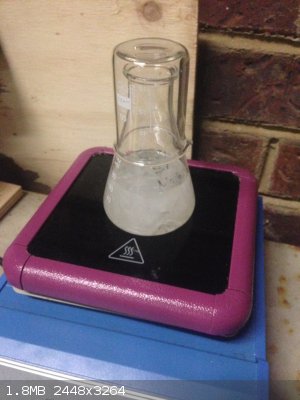 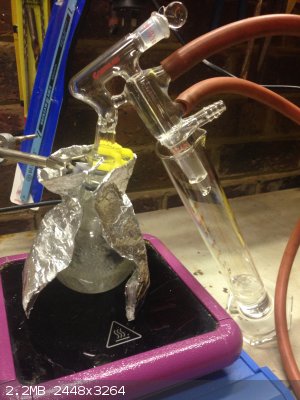 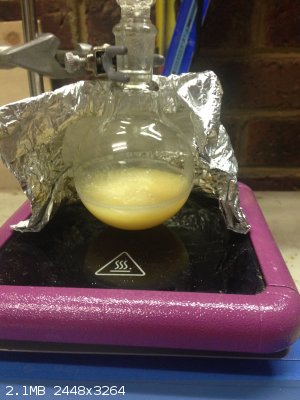
|
|
|
Volanschemia
Hazard to Others
  
Posts: 340
Registered: 16-1-2015
Location: Victoria, Australia
Member Is Offline
Mood: Pretty much all of them!
|
|
I too, just did this today, although I haven't gotten to the acidification stage yet. I cut up 50g of vinyl tubing and ran a soxhlet extraction on
them with 99% Propan-2-ol for a few hours, until the tubing was stiff. I then added 14g of NaOH in 50mL of water and immediately it separated into
two layers. The top layer being a yellow oily mixture of 2-Ethylhexanol and Propan-2-ol and the bottom aqueous Sodium Phthalate. Tomorrow I'll add
some more water (about 100mL I think) and reflux it for a few hours, then acidify it. Hopefully it all goes to plan. I'm planning on using it to get
to Methyl 2-Aminobenzoate.
Anyway, I'll post back here with my progress.
"The chemists are a strange class of mortals, impelled by an almost insane impulse to seek their pleasures amid smoke and
vapor, soot and flame, poisons and poverty; yet among all these evils I seem to live so sweetly that may I die if I were to change places with the
Persian king" - Johann Joachim Becher, 1635 to 1682.
|
|
|
HeYBrO
Hazard to Others
  
Posts: 289
Registered: 6-12-2013
Location: 'straya
Member Is Offline
Mood: 
|
|
Phthalic anhydride from vinyl gloves cont.
After allowing the saponified solution to sit over night the following was obtained. As evidenced by the photo, there appears to be a small layer
which has cleared. After the addition of a few drops of 28 % HCl a white solid precipitated, along with a large volume of white fumes. Confused by the
apparent lack of an aqueous layer, distilled water was added to the remaining organic layer in an attempt to recover the remaining disodium phthalate.
It is currently separating. Once it has fully separated ill see if i can squeeze some more phthalic acid out.
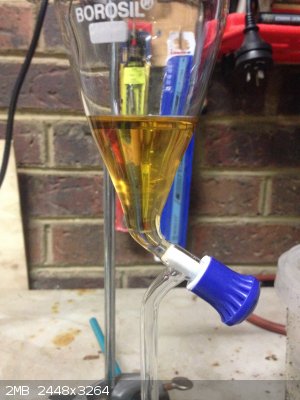 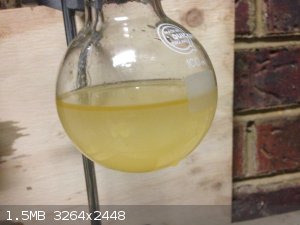
[Edited on 12-7-2015 by HeYBrO]
Attachment: phpSIhI4C (2.1MB)
This file has been downloaded 709 times
|
|
|
gatosgr
Hazard to Others
  
Posts: 237
Registered: 7-4-2015
Member Is Offline
Mood: No Mood
|
|
It's cheaper /easier to buy phthalimide and synthesize phthalic acid from there.
|
|
|
Volanschemia
Hazard to Others
  
Posts: 340
Registered: 16-1-2015
Location: Victoria, Australia
Member Is Offline
Mood: Pretty much all of them!
|
|
Yes, but not so OTC as starting from vinyl.
I'm actually planning on making Phthalimide from Phthalic Anhydride, and from that to 2-hydroxybenzoic Acid for esterification to Methyl
2-Hydroxybenzoate as detailed in a few of Nile Red's videos.
Another long term project is synthesizing Luminol entirely from reagents I can buy OTC in my local area. Similar to what NurdRage did, but some of
the chemicals he used are not available OTC here, so I will have to synthesize them from scratch as well. (ie. I think most people from the US and
Canada can buy Potassium Nitrate and Sodium Metabisulphite in the form of stump remover, whereas here, there is no such thing as chemical stump
remover.)
[Edited on 13-7-2015 by TheAustralianScientist]
"The chemists are a strange class of mortals, impelled by an almost insane impulse to seek their pleasures amid smoke and
vapor, soot and flame, poisons and poverty; yet among all these evils I seem to live so sweetly that may I die if I were to change places with the
Persian king" - Johann Joachim Becher, 1635 to 1682.
|
|
|
gatosgr
Hazard to Others
  
Posts: 237
Registered: 7-4-2015
Member Is Offline
Mood: No Mood
|
|
Yes I meant to say to start from phthalic anhydride not phthalimide since it's cheaper. If you find an OTC way to make phthalics tell me.
|
|
|
Volanschemia
Hazard to Others
  
Posts: 340
Registered: 16-1-2015
Location: Victoria, Australia
Member Is Offline
Mood: Pretty much all of them!
|
|
You can make Phthalic Acid and Phthalic Anhydride OTC.
First, find a a product made of vinyl that contains the plastisizer Bis(2-Ethylhexyl)phthalate (Other Names: Diethylhexyl Phthalate, Dioctyl
Phthalate, DEHP, DOP). A lot of people use vinyl gloves, I used vinyl tubing.
Extract the plastisizer using 2-Propanol. You can use a Soxhlet if you have one, but refluxing the vinyl in 2-Propanol will also work.
Cleave the ester bonds by adding Sodium Hydroxide solution and refluxing. Separate the two layers and save the aqueous layer, then acidify with
Hydrochloric Acid. Place the solution in the freezer to crystallize Phthalic Acid.
To make Phthalic Anhydride, heat the Phthalic Acid until it decomposes to Phthalic Anhydride and starts to sublimate, and collect the vapours.
The procedure is detailed in this Nile Red video and uses entirely OTC chemicals (where I live anyway).
"The chemists are a strange class of mortals, impelled by an almost insane impulse to seek their pleasures amid smoke and
vapor, soot and flame, poisons and poverty; yet among all these evils I seem to live so sweetly that may I die if I were to change places with the
Persian king" - Johann Joachim Becher, 1635 to 1682.
|
|
|
Volanschemia
Hazard to Others
  
Posts: 340
Registered: 16-1-2015
Location: Victoria, Australia
Member Is Offline
Mood: Pretty much all of them!
|
|
Welp, I just acidified my Sodium Phthalate solution and got an immediate whiteish precipitate. I'm hoping that this is not another isomer of Phthalic
Acid, and that there was simply too much Phthalate in the solution and it fell out. Fingers crossed! It's in the freezer at the moment. I'll update
you here on what happens. I guess the ultimate test will be seeing if it decomposes to Phthalic Anhydride.
"The chemists are a strange class of mortals, impelled by an almost insane impulse to seek their pleasures amid smoke and
vapor, soot and flame, poisons and poverty; yet among all these evils I seem to live so sweetly that may I die if I were to change places with the
Persian king" - Johann Joachim Becher, 1635 to 1682.
|
|
|
UC235
National Hazard
   
Posts: 565
Registered: 28-12-2014
Member Is Offline
Mood: No Mood
|
|
Quote: Originally posted by TheAustralianScientist  | | Welp, I just acidified my Sodium Phthalate solution and got an immediate whiteish precipitate. I'm hoping that this is not another isomer of Phthalic
Acid, and that there was simply too much Phthalate in the solution and it fell out. Fingers crossed! It's in the freezer at the moment. I'll update
you here on what happens. I guess the ultimate test will be seeing if it decomposes to Phthalic Anhydride. |
I don't see what the problem is. You should be removing as much liquid from the white precipitate as possible, redissolving it in a minimum of boiling
distilled water, and allowing to cool undisturbed.
|
|
|
Volanschemia
Hazard to Others
  
Posts: 340
Registered: 16-1-2015
Location: Victoria, Australia
Member Is Offline
Mood: Pretty much all of them!
|
|
I would prefer to keep the alcohols it is dissolved in, so I am filtering off the precipitate now (while it is below 0C) and I will test if it is
Phthalic Acid. If it is, I'll distill off most of the alcohol and evaporate the rest, then do as you suggested.
"The chemists are a strange class of mortals, impelled by an almost insane impulse to seek their pleasures amid smoke and
vapor, soot and flame, poisons and poverty; yet among all these evils I seem to live so sweetly that may I die if I were to change places with the
Persian king" - Johann Joachim Becher, 1635 to 1682.
|
|
|
gatosgr
Hazard to Others
  
Posts: 237
Registered: 7-4-2015
Member Is Offline
Mood: No Mood
|
|
anybody knows how to make terephthalic acid?
or even isophthalic acid?
I've found this method but I don't know how pure of a product you can get, I want to make another polymer from terephthalic acid.
http://www.sciencemadness.org/member_publications/terephthal...
[Edited on 14-7-2015 by gatosgr]
|
|
|
| Pages:
1
2 |